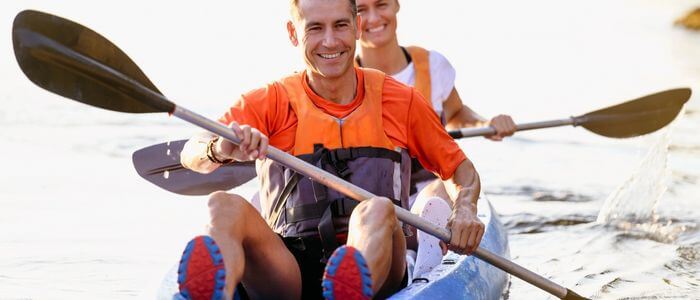
Have you just started kayaking and are wondering which type of kayak is easier to handle a solo or tandem kayak? Or you’re an experienced kayaker considering switching to tandem kayaking but are still determining if it is easier than solo kayaking.
Don’t worry; here is a detailed guide that will help you know everything about Tandem and Solo kayaking and which one is better.
So, let’s get started.

There is no definitive answer to this question, as it depends on several factors. For example, if you are starting with kayaking and want something easy to learn and navigate, then a solo kayak is likely the better choice. Solo kayaks are more lightweight and maneuverable than tandem boats, making them ideal for beginners.
However, tandem kayaks may be more appropriate if you are looking for a longer or more challenging paddling trip – such as a multi-day kayaking or camping trip. These boats tend to be more stable, allowing you to easily handle larger bodies of water and any unexpected conditions that come up along the way. Furthermore, if you are going on a longer trip, carrying a tandem kayak will likely be much easier than carrying two solo kayaks.
The best choice for your kayaking needs depends on your experience level and the type of trip you plan on taking. If you’re new to paddling or want something simple and easy to use, then a solo kayak is the best option. However, if you are looking for something more versatile and suitable for longer or more demanding trips, then tandem kayaking may be the way to go.
Whichever choice you make, remember that with careful planning and preparation, solo and tandem kayaking can be enjoyable experiences for any level of paddler!
To understand whether or not tandem kayaking is easier than solo kayaking, it is important to consider several factors. Let’s discuss those factors in detail.
One of the main factors determining whether tandem kayaking is easier than solo kay is your experience level. If you start kayaking, a solo boat may be easier for beginners to learn and navigate since these boats tend to be more lightweight and maneuverable than tandem boats.
In contrast, if you have some experience with paddling and are interested in tackling longer or more challenging trips – such as multi-day camping trips or extended expeditions – then a tandem boat may be the better choice. Tandem boats tend to be more stable and can easily handle larger bodies of water, making them ideal for experienced paddlers who want a versatile boat that can take on various conditions.
Another important factor to consider when deciding whether tandem kayaking is easier than solo kayaking is the type of trip you are planning. A solo kayak may be the best option if you are just getting started with paddling and want something simple and easy to use.
However, if you are looking for something more versatile that can handle longer or more challenging trips – such as multi-day camping or expeditions – then tandem kayaking may be your best bet. These boats tend to be more stable and durable, allowing them to easily handle larger bodies of water and any unexpected conditions that come up along the way.
In addition to considering your level of experience and the kind of trip you are planning, it is also important to consider how easy it will be to carry your kayak. Tandem kayaks are typically easier to carry than solo boats since they tend to be larger and heavier.
This can make a big difference if you are going on a longer or more demanding trip, where having an easier time carrying your boat may be essential for enjoying your time on the water.
When choosing between a solo kayak and a tandem kayak, there are several factors to consider, including stability, tracking, and weight.
Stability refers to how well the kayak can maintain its balance and resist tipping over. Tandem kayaks are generally more stable than solo kayaks because they are wider and have more surface area in contact with the water. This makes them ideal for beginner paddlers or those who want a more stable ride. On the other hand, Solo kayaks are typically narrower and less stable, making them more challenging to paddle but also more agile and responsive.
Tracking refers to how well the kayak can maintain a straight course while paddling. Tandem kayaks track better than solo kayaks because they are longer and have more surface area in contact with the water. On the other hand, Solo kayaks are typically shorter and narrower, making them more difficult to keep on a straight course.
Weight is another important factor when choosing between a solo and tandem kayak. Tandem kayaks are generally heavier than solo kayaks because they are larger and have more features, such as extra seating and storage space. This can make them more difficult to transport and carry on and off the water. Solo kayaks are typically lighter and easier to handle, which can be an advantage if you do a lot of portaging or need to carry your kayak over long distances.
Finally, it is important to consider your efficiency when deciding whether tandem kayaking is easier than solo kayaking. While solo boats may be more lightweight and maneuverable, they may not allow you to move as quickly or precisely on the water.
Ultimately, the best option for you will depend on your level of expertise, the type of trip you are planning, and your personal preferences.
To help you make an informed decision about which type of boat is right for you, consider these different factors and talk to experienced paddlers for their advice and recommendations. With some planning and preparation, solo and tandem kayaks can provide you hours of fun on the water.
Following are some common questions that might come into your mind when deciding between tandem or solo kayaks.
Technically, you can solo a tandem kayak by sitting in the back seat and using a single-blade paddle. However, tandem kayaks are generally not designed to be paddled solo and may not perform as well as a solo kayak in terms of stability and tracking.
Solo kayaks are typically narrower and more streamlined, which makes them easier to paddle and maneuver. Tandem kayaks are usually wider and more stable, but this can make them more difficult to paddle solo. If you are planning on kayaking by yourself, it is generally a better idea to use a solo kayak rather than trying to solo a tandem kayak.
Technically, two people can ride in a solo kayak, but it is generally not recommended. Solo kayaks are designed for a single paddler and are not meant to be used by two people. They are typically narrower and less stable than tandem kayaks, designed for two paddlers.
If two people try to ride in a solo kayak, it can be difficult to balance the weight evenly, and the kayak may be unstable and hard to control. Additionally, solo kayaks typically need more space for two people to sit comfortably or store all their gear. It is generally a better idea for two people to use a tandem kayak specifically designed for two paddlers.
When deciding between tandem and solo kayaks, there are several important factors to consider. Ultimately, the best option for you will depend on your experience level and personal preferences regarding kayaking and whether you have a fellow friend willing to kayak with you! To help you make an informed decision about which type of boat is right for you, it is important to consider all of the different factors written above.

Hey there kayak lovers! I’m Jay Schwartz, the author here at Kayak Guidance! You know water sports – you know me! My life is all about it. Kayaking, Paddleboarding, Fishing, Snorkeling and so much more. I love to share my passion and knowledge with all of you.

Hey there kayak lovers! I’m Jay Schwartz, the author here at Kayak Guidance! You know water sports – you know me! My life is all about it. Kayaking, Paddleboarding, Fishing, Snorkeling and so much more. I love to share my passion and knowledge with all of you.

Welcome to KayakGuidance.com! If you’re looking to have some fun outdoor water adventures, then you have come to the right place. We help our readers find the best kayaks and water related equipment to help you have the best time of your life whenever you are engaging in water activities.
This site is a participant in the Amazon services LLC associates program, an affiliate advertising program designed to provide a means for sites to earn advertising fees by advertising and linking to Amazon.com.